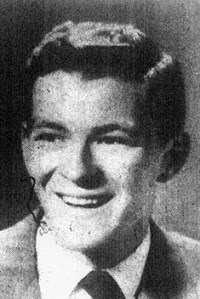Breaking the color barrier: Stopping for a snack
Published 6:44 pm Saturday, February 25, 2023

- The College Shoppe, which opened in 1936, was purchased by the town in March of 1977, 16 years after the Norview High School football team ate there. It was eventually torn down to make way for the present Farmville Town Hall building.
|
Getting your Trinity Audio player ready...
|
By Dr. Ray A. Gaskins
Editor’s note: This is the second in a three-part series by Dr. Gaskins on the struggle to break the color barrier in public school sports.
As its second game in 1961, Norview High School played E.C. Glass in Lynchburg. Both teams were billed as powerhouses — Glass had won three previous state championships and Norview two — so 18,000 fans showed up to watch the game. E.C. Glass won that football game but both teams went on to win their respective conferences — Glass won the Western District Championship and Norview won the Eastern District Championship.

Milton Ray Keeling (1930-1977) took over the College Shoppe when his father retired in 1968. When Ray died suddenly on Sunday February 26, 1977, Jack was forced out of retirement long enough to negotiate the sale of the restaurant property to the town. Jack died May 8, 1988.
Trending
The road from Norfolk to Lynchburg in 1961 was Highway 460 West. Since the Farmville 460 Bypass did not open until Friday, May 5, 1978, the team bus came right through town on Third Street. There were no places where the speed limit exceeded 55 MPH, so the trip from Norfolk to Farmville was about three hours. By the time they hit town, the team was getting restless, so the team bus stopped for a snack at a restaurant in Farmville.
Everything was fine as the players filed into the dining room, until Andy walked through the door and sat down. The manager then told Coach John Moody that he would not be able to serve the team unless Andy ate in the kitchen. When Coach Moody broke the news to Andy, he was heartbroken, but as he got up to go in the kitchen, so did Ken and Zongo.
The three friends ate in the kitchen while the rest of the team ate in the dining room, where Dolly Braxton was their waitress. What is truly ironic is that the threesome couldn’t help but notice that the kitchen staff was all black, including the cook, Robert Smith. Andy would later recall that the kitchen table was huge and that the kitchen staff were all-smiles at the “honor” of their unexpected company. He took solace in the thought that they were probably being better fed in the kitchen than the rest of the team was in the dining room; nevertheless, being forced to eat in the kitchen was an insult that he, and the team, would never forget.
‘Only a handful of Farmville restaurants’
There were only a handful of Farmville restaurants on the 460 corridor in 1961 big enough to feed a football team: Cedar Brook, The College Shoppe, Greyhound Post House, Gunn’s Truck Stop, James Madison Inn, and Reid’s Cafe. Reid’s Cafe can be ruled out because its Black manager would not have made Andy eat in the kitchen. The Post House can also be ruled out because the Interstate Commerce Commission outlawed segregation in all interstate transportation facilities in 1961, making it the first truly integrated restaurant in Farmville. None of these six restaurants have survived to the present.
At the Friday night gala before the 2012 Virginia Tech spring football game, John Moody told me a story that eliminated all but one of the remaining restaurants. He said Norview parked the team bus on the street and the coaches went inside to organize the meal. In the meantime, Andy, Ken, Zongo, and some of the other players got off the bus to stretch their legs. When they looked up, they found themselves standing in front of the “Prince Edward County Courthouse” building. As the realization of where they were dawned on them, they quickly formed a phalanx around Andy and escorted him back to the bus. Thus, the restaurant in question must have been The College Shoppe, because it was located on the same side of Main Street and just a few feet south of the Courthouse.
Jack E. Pearlove opened The College Shoppe at 114 North Main Street on September 12, 1936. Jack Milton Keeling (1909-1988) took over from Pearlove in 1959 and bought the building in 1961. (John G. Shannon opened Shannon’s at 126 North Main Street in 1909. In 1916, he moved into the brand new Pearlove building at 114 North Main Street. After its 20-year lease expired, Shannon’s relocated to 106 North Main Street and tried to upstage The College Shoppe’s opening with its own reopening just nine days later.)
‘He did what he could’
Trending
Keeling hated to make Andy eat in the kitchen but he had a wife and six children to support. Allowing Andy to eat in the main dining room would have doomed his restaurant — such was the racial climate in Farmville at that time. Instead, he did what he could, which in this instance was to let Andy eat in the kitchen for free. (The Greyhound bus terminal was not far from the restaurant. Until the ICC’s action in 1961, Keeling, who served as a Navy cook in WW2, offered Black servicemen traveling by bus a free meal in his kitchen.)
As it turned out, having to eat in the kitchen worked to Andy’s advantage. For the rest of the season, except for the halfback he beat out for the starting job, he had no further problems with his teammates, who now came together to form a solid bond as a result of the Farmville restaurant incident.
But there were other problems. Some of Norview’s usual opponents refused to play them in 1961, making it difficult to play a full schedule. My high school, Great Bridge, stepped up to the plate and agreed to play them, with one condition: the game had to be played on Sunday afternoon in order to minimize the possibility of fan violence. The thinking was that it would be safer to play before football fans that had just gotten out of church than those who had just had a few Friday night drinks.
Andy, a serious Christian, was so worried about playing on the Sabbath that he had a terrible game, fumbling the ball four times. In what turned out to be an exciting game, Norview edged Great Bridge 9 to 7. In the Great Bridge stands were some former Norview students, who, not knowing that Norview would only be closed for one semester, transferred to Great Bridge in 1958.
The last game of the season
The last game of the season was against Maury and would decide the 1961 Virginia Eastern District Championship. So many people wanted to attend that game that it was moved to Norfolk’s Forman Field. Over 30,000 people showed up — the 5th largest crowd in Forman Field history — and Andy did not disappoint, helping Norview defeat Maury 20-0. He ran for more than 100 yards, including a 54-yard touchdown.
In spite of his outstanding play during the 1961 season, Andy was not named to any honorary team, did not receive any award, and did not attend the Senior Prom. To remedy this situation, the Black community in Norfolk staged a surprise “awards” banquet for him. None other than Jim Brown of the Cleveland Browns was there to present Andy with a huge trophy as the “Most Outstanding Black Athlete in Virginia.” Nevertheless, Andy still treasures his The 1962 Pilot yearbook, in which many students wrote nice things, e.g., one of the nicest was: “Before I met you, Andy, colored people were (censored), but now they are human. I wish to thank you for the opportunity to see the light for you are a great guy.”
Andy graduated from Norview High School in June of 1962. From 1962-66 he played football for the Norfolk State Spartans, where he majored in chemistry. He did not graduate, perhaps because his real ambition at that point in his life was to play professional football. He was given a tryout by the Pittsburgh Steelers but was released in 1967. Thus, instead of pursuing a career in the NFL, he signed with Industrial National Bank of Providence, Rhode Island, and pursued a career in banking, becoming the bank’s first Black branch manager, credit officer, and commercial loan officer. He later moved to Barclays Bank of New York and Banco de Ponce-New York as a vice president and corporate manager.
Jim Brown was the perfect choice to present Andy with that trophy in 1961. He was initially made to feel just as unwelcome at Syracuse in 1953 as Andy was at Norview in 1959. He was not recruited, was not offered an athletic scholarship, and was not allowed to live in an athletic dorm. Unlike Andy, Jim even considered quitting, but both soldiered on until graduation.
Dr. Ray A. Gaskins serves as professor emeritus at Hampden-Sydney College.





